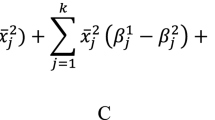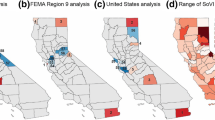Abstract
In recent years, both in socialscience and policy circles, there has been agrowing consensus on the multidimensionalnature of poverty. However, theoperationalisation of the concept has notfollowed this development, as most studies arestill primarily based on income. In thisarticle, we propose to measure the concept ofpoverty using both monetary and non-monetaryindicators. To this end, a latent classmeasurement model is used, allowing us to takeaccount of the multidimensionality of the dataand the discrete nature of most availablepoverty indicators. The proposed measurementinstrument allows for poverty to manifestitself in different ways or forms for differentsubgroups in the population. Furthermore, theoccurrence of multiple deprivation, rather thana `negative' score on only one indicator, istaken into account. In addition, specialattention is paid to the feasibility ofconstructing a multidimensional poverty measurewhich can be used to study poverty dynamicswith longitudinal panel data. We presentfigures on the size and the social distributionof the `poor' population in Belgium andBritain. These figures indicate that theresults of our multidimensional measurementprocedure are both plausible and substantivelyinterpretable.
Similar content being viewed by others
REFERENCES
Atkinson, T., B. Cantillon, E. Marlier and B. Nolan: 2002, Social Indicators. The EU and Social Inclusion (Oxford University Press, Oxford).
Bardasi, E., S.P. Jenkins and J. Rigg: 2001, Documentation for Derived and Annual Net Household Income Variables, BHPS waves 1-9, Institute for Social and Economic Research (University of Essex, Colchester).
British Household Panel Survey, ESRC Research Centre on Micro-Social Change, data files and associated documentation (The Data Archive, Colchester).
Cheli, B. and A. Lemmi: 1995, ‘A “totally” fuzzy and relative approach to the multidimensional analysis of poverty', Economic Notes 24, pp. 115-134.
Collins, L.M. and B.P. Flaherty: 2002, ‘Latent class models for longitudinal data', in J.A. Hagenaars and A.L. McCutcheon (eds.), Applied Latent Class Analysis (Cambridge University Press, Cambridge), pp. 287-303.
Dale, A. and R.B. Davies: 1994, ‘Introduction', in A. Dale and R.B. Davies (eds.), Analysing Social and Political Change. A Casebook of Methods (Sage Publications, London), pp. 1-19.
De Decker, P. and V. Geurts: 2000, ‘Wonen. Residualiseert de huursector?', in J. Vranken, D. Geldof and G. Van Menxel (eds.), Armoede en sociale uitsluiting. Jaarboek 2000 (Acco, Leuven), pp. 193-203.
De Decker, P. and I. Pannecoucke: 2001, ‘Wonen', in J. Vranken, D. Geldof, G. VanMenxel and J. Van Ouytsel (eds.), Armoede en sociale uitsluiting. Jaarboek 2001 (Acco, Leuven), pp. 243-261.
De Keulenaer, F. and C. Dewilde: 2001, ‘Op weg naar een multi-aspectuele armoedemaat', in J. Vranken, D. Geldof, G. Van Menxel and J. Van Ouytsel (eds.), Armoede en sociale uitsluiting. Jaarboek 2001 (Acco, Leuven), pp. 135-150.
Dewilde, C., A. Bauwens, R. Marijnissen and J. Lauwers: 2000, Panel studie van Belgische huishoudens.Methodebericht golf 6 (1997) (Steunpunt Gezinsdemografisch Panel, Universiteit Antwerpen).
Dewilde, C.: 2002a, ‘The financial consequences of relationship dissolution for women in western Europe', in E. Ruspini and A. Dale (eds.), The Gender Dimension of Social Change. The Contribution of Dynamic Research to the Study of Women's Life Courses (The Policy Press, Bristol), pp. 81-110.
Dewilde, C.: 2002b, ‘De impact van life events op sociale uitsluiting en armoede', in J. Vranken, K. De Boyser, D. Geldof and G. Van Menxel (eds.), Armoede en sociale uitsluiting. Jaarboek 2002 (Acco, Leuven), pp. 55-69.
Dewilde, C.: 2003, ‘A life-course perspective on social exclusion and poverty', British Journal of Sociology 54, pp. 109-128.
Dewilde, C. and De Keulenaer, F.: 2002, ‘Huisvesting: De “vergeten” dimensie van armoede', Ruimte en planning 22, pp. 99-118.
Dewilde, C. and De Keulenaer, F.: forthcoming, ‘Housing and poverty: The “missing link” ‘, European Journal of Housing Policy.
Dewilde, C. and K. Levecque: 2002, ‘De mobiliteit in en uit armoede: “Wie is arm en voor hoe lang?”, in J. Vranken, K. De Boyser, D. Geldof and G. Van Menxel (eds.), Armoede en sociale uitsluiting. Jaarboek 2002 (Acco, Leuven), pp. 85-103.
Eurostat: 2000, ECHP Data Quality-Second Report, Doc PAN108/99 revised (Working Group ‘European Community Household Panel', European Commission).
Finkel, S.E.: 1995, Causal Analysis with Panel Data, Sage University Paper Series on Quantitative Applications in the Social Sciences (Sage Publications, Thousand Oaks).
Gallie, D.: 1999, ‘Unemployment and Social exclusion in the European Union', European Societies 1, pp. 139-167.
Goodman, L.A.: 2002, ‘Latent class analysis: The empirical study of latent types, latent variables, and latent structures', in J.A. Hagenaars and A.L. McCutcheon (eds.), Applied Latent Class Analysis (Cambridge University Press, Cambridge), pp. 3-55.
Hagenaars, J.A.: 1990, Categorical Longitudinal Data. Log-Linear Panel, Trend and Cohort Analysis (Sage Publications, Newbury Park).
Hagenaars, J.A.: 1993, Loglinear Models with Latent Variables, Sage University Paper Series on Quantitative Applications in the Social Sciences (Sage Publications, Newbury Park).
Hagenaars, J.A.: 2002, ‘Directed loglinear modeling with latent variables. Causal models for categorical data with nonsystematic and systematic measurement errors', in J.A. Hagenaars and A.L. McCutcheon (eds.), Applied Latent Class Analysis (Cambridge University Press, Cambridge), pp. 234-286.
Jacobs, T. and R. Marynissen.: 1993, Panel Studie van Belgische Huishoudens. Methodebericht golf 1 (1992) (Steunpunt Gezinsdemografisch Panel, Universiteit Antwerpen).
Kangas, O. and V.-M. Ritakallio: 1998, ‘Different methods-different results? Approaches to multidimensional poverty', in H.-J. Andreß (ed.), Empirical Poverty Research in a Comparative Perspective (Ashgate, Aldershot), pp. 167-203.
Langeheine, R. and F. van de Pol: 1994, ‘Discrete-time mixed markov latent class models', in A., Dale and R.B. Davies (eds.), Analysing Social and Political Change. A Casebook of Methods (Sage Publications, London), pp. 167-197.
Langeheine, R. and F. van de Pol: 2002, ‘Latent Markov chains', in J.A. Hagenaars and A.L. McCutcheon (eds.), Applied Latent Class Analysis (Cambridge University Press, Cambridge), pp. 304-341.
Layte, R., B. Maître, B. Nolan and C.T. Whelan: 2000, Explaining Levels of Deprivation in the European Union, EPAG, Working Paper 12 (University of Essex, Colchester), http://www.iser.essex.ac.uk/epag/pubs/.
McCutcheon, A.L.: 1987, Latent Class Analysis, Sage University Paper Series on Quantitative Applications in the Social Sciences (Sage Publications, Newbury Park).
McCutcheon, A.L.: 2002, ‘Basic concepts and procedures in single-and multiple-group latent class analysis', in J.A. Hagenaars and A.L. McCutcheon (eds.), Applied Latent Class Analysis (Cambridge University Press, Cambridge), pp. 56-87.
Øyen, E.: 1996, ‘Poverty research rethought', in E. Øyen, S.M. Miller and S.A. Samad (eds.), Poverty: A Global Review. Handbook on International Poverty Research, (Scandinavian University Press, Oslo), pp. 3-17.
Pratschke, J. and T. Haase: 2000, Structures of Disadvantage: Spatial and Theoretical Aspects of Index Construction, Paper presented at the Fifth International Conference on Logic and Methodology, Cologne, 3-6 October 2000.
Piachaud, D.: 1981, ‘Peter Townsend and the Holy Grail', New Society 57, pp. 419-421.
Piachaud, D.: 1987, ‘Problems in the definition and measurement of poverty', Journal of Social Policy 16, pp. 147-164.
Ringen, S.: 1988, ‘Direct and indirect measures of poverty', Journal of Social Policy 17, pp. 351-365.
Taylor, M.F. (ed.), with J. Brice, N. Buck and E. Prentice-Lane: 2001, British Household Panel Survey User Manual Volume A: Introduction, Technical Reports and Appendices (University of Essex, Colchester).
Townsend, P.: 1979, Poverty in the United Kingdom. A Survey of Household Resources and Standards of Living (Penguin Books, Hammondsworth).
Vranken, J.: 2001, ‘Unravelling the social strands of poverty: Differentiation, fragmentation, inequality, and exclusion', in H.T. Andersen and R. Van Kempen (eds.), Governing European Cities. Social Fragmentation, Social Exclusion and Urban Governance (Ashgate, Aldershot), pp. 71-91.
Vermunt, J.: 1997, LEM: A General Program for the Analysis of Categorical Data (Tilburg University, Tilburg).
Whelan, B.J. and C.T. Whelan: 1995, ‘In what sense is poverty multidimensional?’, in G. Room (ed.), Beyond the Threshold. The Measurement and Analysis of Social Exclusion (The Policy Press, Bristol), pp. 29-48.
Whelan, C.T., R. Layte, B. Maître and B. Nolan: 2001, Persistent Income Poverty and Deprivation in the European Union: An Analysis of the First Three Waves of the European Community Household Panel, EPAG, Working Paper 17 (University of Essex, Colchester), http://www.iser.essex.ac.uk/epag/pubs/.
Author information
Authors and Affiliations
Rights and permissions
About this article
Cite this article
Dewilde, C. The Multidimensional Measurement of Poverty in Belgium and Britain: A Categorical Approach. Social Indicators Research 68, 331–369 (2004). https://doi.org/10.1023/B:SOCI.0000033578.81639.89
Issue Date:
DOI: https://doi.org/10.1023/B:SOCI.0000033578.81639.89




